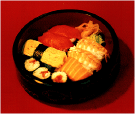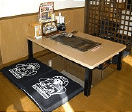Emperor's Dinner
A WebQuest for 5th Grade Social Studies
Tyler Kobayashi
 |
 |
 |
|||
|
Click on pictures to go back to Tyler's homepage
|
|||||
Introduction | Task | Process | Evaluation | Conclusion | Credits | Teacher Page
Introduction
You are invited! The emperor of Japan has invited you to dinner! You have the honor to cook and eat with him! It sounds like a blast, but wait - in Japan the food and culture is a little different from ours in America. Let's explore the different recipes and table etiquette (manners) that the Japanese use so we can make a good impression on the emperor.
Task
You are invited to eat with one of the most important figures in Japan. You need to be ready so you can impress him. You need to learn three things in order to impress the emperor. Find an authentic Japanese food recipe, its nutritional content and finally learn some Japanese food etiquette (manners).
You will be able to search the internet and books provided to find recipes, graphics, nutritional content, etiquette information, and ingredients.
With this information you will make a poster explaining what recipe you found, a list of ingredients you needed to prepare the dish, and information on Japanese food etiquette.
Process
Poster requirement:
1) Find a recipe that looks interesting to you. Place any graphics or pictures you found of the food on your poster. Here are a few links to help you on your recipe search
- http://japanesefood.about.com/library/recipe/blrecipe_index.htm
- http://www.japan-guide.com/e/e2035.html
2) After finding a recipe list the ingredients on the poster and also place them in the proper section of the Japanese Food pyramid. Here is a helpful link:
http://www.semda.org/info/pyramid.asp?ID=10. Draw finished food pyramid on poster.
3) Prepare the dish at home with a parent.
4) While preparing your dish you may have used some of your math abilities to measure the ingredients. What would you need to do in order to double your recipe just in case the emperor invites a few more of his buddies? Here is a helpful link -
http://educ.queensu.ca/~fmc/july2005/WeekendRecipe.html.
Paste answer and computations on poster.
5) Search for Japanese food etiquette (manners) and place a minimum of 8 of your findings on the poster. Here are some helpful links and books to help you get started on your search:
http://www.japan-guide.com/e/e2005.html - table manners
http://www.japan-guide.com/e/e2006.html - proper sitting techniques
http://gojapan.about.com/cs/tablemanners/a/tablemanner.htm - more table manners
6) List internet sites used on your poster.
Report:
1) Write a report of your experience. Your report should include:
How did you find the recipe: What type of food were you interested in finding, a desert, a dinner dish, or maybe an appetizer? What site did you find your recipe on?
Cooking experience: Did you have most of the ingredients at home, or did you have to go shopping for them? How did your recipe turn out after cooking it? How did your dish come out? Was it good?
Problems: Did you run into any problems? Was there an ingredient(s) that you couldn't find?
Presentation:
1) Present your poster to the class
Evaluation
Describe to the learners how their performance will be evaluated. Specify whether there will be a common grade for group work vs. individual grades. You may want to have separate rubrics for individual and group work.
|
Beginning 1 |
Developing 2 |
Accomplished 3 |
Exemplary 4 |
Score |
|
|---|---|---|---|---|---|
|
List of Ingredients
|
Does not list ingredients. | Lists 50% of ingredients. | Lists 70% of ingredients. | Lists 100% of ingredients. | |
|
Report
|
Report is missing all three elements: how you found the recipe, cooking experience, and problems | Report only consists of one of the three elements the of report. | Report consists of 2 of the three elements of the report. | Report consists of all three elements of the report. | |
|
Food Etiquette
|
Found less than 2 different food manners. | Found between 2-4 different food manners. | Found between 5-7 different food manners. | Found 8 or more different food manners. | |
|
Use of math in the cooking process
|
Calculates 50% or less of the ingredients correctly | Calculates 70% of the ingredients correctly | Calculates 80% of the ingredients correctly. | Calculates 100% of the ingredients correctly. | |
|
Nutrition
|
Student did not show effort to place ingredients in the proper category of the Japanese food pyramid. | Student showed minimal effort and placed 50% of ingredients in the proper category of the Japanese Food pyramid. | Student showed effort and placed 75% of the ingredients in their proper category of the Japanese Food pyramid | Student placed all ingredients in their proper category of the Japanese Food pyramid. | |
|
Presentation
|
Student does not participate in the presentation. | Student chooses to only explain 1-3 elements of the poster. | Student chooses to explain only 4-5 elements of the poster. | Student presents all elements to the class. |
Conclusion
Congratulations! The emperor of Japan enjoyed the food you made him and was very impressed with your food etiquette. You have just learned about the different types of food the Japanese eat everyday along with the nutritional value of the food item you made. You also learned about proper food etiquette and are now more versed in the Japanese culture.
Credits & References
“A Dictionary of Japanese Food” by Richard Hosking
“Japanese Food: A Timeless Cuisine” by Emiko Kasuko
Pictures can be found at:
http://www.japan-guide.com/e/e2005.html
http://www.bento.com/tf-recp.html#recipes
We all benefit by being generous with our work. Permission is hereby granted for other educators to copy this WebQuest, update or otherwise modify it, and post it elsewhere provided that the original author's name is retained along with a link back to the original URL of this WebQuest. On the line after the original author's name, you may add Modified by (your name) on (date). If you do modify it, please let me know and provide the new URL.
Based on a template from The WebQuest Page